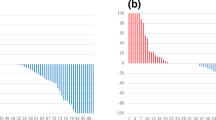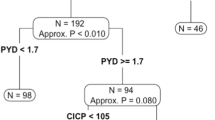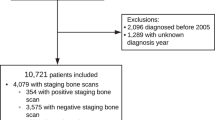Abstract
Background:
To evaluate the factors associated with positive bone scans after biochemical recurrence (BCR) following radical prostatectomy in both hormone-naive subjects and subjects after androgen-deprivation therapy (ADT).
Methods:
Retrospective analysis of 380 bone scans of 301 hormone-naive subjects and 214 bone scans of 137 subjects after ADT following BCR from the Shared Equal Access Regional Cancer Hospital database. Generalized estimating equations and local regression plots were used to evaluate bone scan positivity by patients’ demographics, pathological features, PSA levels and kinetics.
Results:
Among hormone-naive subjects and subjects on ADT, bone scan positivity was seen in 24 (6%) and 65 (30%) subjects, respectively. In hormone-naive subjects, the higher prescan PSA, higher PSA velocity (PSAV) and shorter PSA doubling time (PSADT) were significantly associated with positive scans (P=0.008, P<0.001 and P<0.001, respectively). In subjects after ADT, the prescan PSA, PSAV and PSADT were significantly associated with positive scans (P=0.011, P<0.001 and P=0.002, respectively). Regression plots showed increased scan positivity with increasing PSA levels and shortening PSADT (all P<0.001) for both hormone-naive subjects and subjects after ADT. For a given PSA level and PSADT, subjects on ADT had higher bone scan positivity.
Conclusions:
In both hormone-naive subjects and subjects after ADT, more aggressive and advanced disease identified by higher PSA levels, higher PSAV and shorter PSADT were associated with higher bone scan positivity. For the same PSA level and PSADT, subjects after ADT had higher bone scan positivity than hormone-naive subjects. Therefore, PSA levels and kinetics may be used as selection criteria for bone scan in these patients.
This is a preview of subscription content, access via your institution
Access options
Subscribe to this journal
Receive 4 print issues and online access
$259.00 per year
only $64.75 per issue
Buy this article
- Purchase on Springer Link
- Instant access to full article PDF
Prices may be subject to local taxes which are calculated during checkout


Similar content being viewed by others
References
Palvolgyi R, Daskivich TJ, Chamie K, Kwan L, Litwin MS . Bone scan overuse in staging of prostate cancer: an analysis of a Veterans Affairs cohort. Urology 2011; 77: 1330–1336.
Moslehi M, Cheki M, Salehi-Marzijarani M, Amuchastegui T, Gholamrezanezhad A . Predictors of bone metastasis in pre-treatment staging of asymptomatic treatment-naive patients with prostate cancer. Rev Esp Med Nucl Imagen Mol 2013; 32: 286–289.
De Nunzio C, Leonardo C, Franco G, Esperto F, Brassetti A, Simonelli G et al. When to perform bone scan in patients with newly diagnosed prostate cancer: external validation of a novel risk stratification tool. World J Urol 2013; 31: 365–369.
Ayyathurai R, Mahapatra R, Rajasundaram R, Srinivasan V, Archard NP, Toussi H . A study on staging bone scans in newly diagnosed prostate cancer. Urol Int 2006; 76: 209–212.
Ishizuka O, Tanabe T, Nakayama T, Kawakami M, Kinebuchi Y, Nishizawa O . Prostate-specific antigen, Gleason sum and clinical T stage for predicting the need for radionuclide bone scan for prostate cancer patients in Japan. Int J Urol 2005; 12: 728–732.
O'Sullivan JM, Norman AR, Cook GJ, Fisher C, Dearnaley DP . Broadening the criteria for avoiding staging bone scans in prostate cancer: a retrospective study of patients at the Royal Marsden Hospital. BJU Int 2003; 92: 685–689.
Ritenour CW, Abbott JT, Goodman M, Alazraki N, Marshall FF, Issa MM . The utilization of Gleason grade as the primary criterion for ordering nuclear bone scan in newly diagnosed prostate cancer patients. Scientific World J 2009; 9: 1040–1045.
Kosuda S, Yoshimura I, Aizawa T, Koizumi K, Akakura K, Kuyama J, Ichihara K et al. Can initial prostate specific antigen determinations eliminate the need for bone scans in patients with newly diagnosed prostate carcinoma? A multicenter retrospective study in Japan. Cancer 2002; 94: 964–972.
Lorente JA, Morote J, Raventos C, Encabo G, Valenzuela H . Clinical efficacy of bone alkaline phosphatase and prostate specific antigen in the diagnosis of bone metastasis in prostate cancer. J Urol 1996; 155: 1348–1351.
Wolff JM, Bares R, Jung PK, Buell U, Jakse G . Prostate-specific antigen as a marker of bone metastasis in patients with prostate cancer. Urol Int 1996; 56: 169–173.
Chybowski FM, Keller JJ, Bergstralh EJ, Oesterling JE . Predicting radionuclide bone scan findings in patients with newly diagnosed, untreated prostate cancer: prostate specific antigen is superior to all other clinical parameters. J Urol 1991; 145: 313–318.
Bruwer G, Heyns CF, Allen FJ . Influence of local tumour stage and grade on reliability of serum prostate-specific antigen in predicting skeletal metastases in patients with adenocarcinoma of the prostate. Eur Urol 1999; 35: 223–227.
Pound CR, Partin AW, Eisenberger MA, Chan DW, Pearson JD, Walsh PC . Natural history of progression after PSA elevation following radical prostatectomy. JAMA 1999; 281: 1591–1597.
Slovin SF, Wilton AS, Heller G, Scher HI . Time to detectable metastatic disease in patients with rising prostate-specific antigen values following surgery or radiation therapy. Clin Cancer Res 2005; 11: 8669–8673.
Okotie OT, Aronson WJ, Wieder JA, Liao Y, Dorey F, De KJ et al. Predictors of metastatic disease in men with biochemical failure following radical prostatectomy. J Urol 2004; 171: 2260–2264.
Dotan ZA, Bianco FJ Jr., Rabbani F, Eastham JA, Fearn P, Scher HI et al. Pattern of prostate-specific antigen (PSA) failure dictates the probability of a positive bone scan in patients with an increasing PSA after radical prostatectomy. J Clin Oncol 2005; 23: 1962–1968.
Loeb S, Makarov DV, Schaeffer EM, Humphreys EB, Walsh PC . Prostate specific antigen at the initial diagnosis of metastasis to bone in patients after radical prostatectomy. J Urol 2010; 184: 157–161.
Smith MR, Kabbinavar F, Saad F, Hussain A, Gittelman MC, Bilhartz DL et al. Natural history of rising serum prostate-specific antigen in men with castrate nonmetastatic prostate cancer. J Clin Oncol 2005; 23: 2918–2925.
Smith MR, Cook R, Lee KA, Nelson JB . Disease and host characteristics as predictors of time to first bone metastasis and death in men with progressive castration-resistant nonmetastatic prostate cancer. Cancer 2011; 117: 2077–2085.
Whitley BM, Moreira DM, Thomas JA, Aronson WJ, Terris MK, Presti JC Jr. et al. Preoperative weight change and risk of adverse outcome following radical prostatectomy: results from the Shared Equal Access Regional Cancer Hospital database. Prostate Cancer Prostatic Dis 2011; 14: 361–366.
Freedland SJ, Sutter ME, Dorey F, Aronson WJ . Defining the ideal cutpoint for determining PSA recurrence after radical prostatectomy. Prostate-specific antigen. Urology 2003; 61: 365–369.
Freedland SJ, Humphreys EB, Mangold LA, Eisenberger M, Dorey FJ, Walsh PC et al. Risk of prostate cancer-specific mortality following biochemical recurrence after radical prostatectomy. JAMA 2005; 294: 433–439.
Sadik M, Suurkula M, Hoglund P, Jarund A, Edenbrandt L . Quality of planar whole-body bone scan interpretations-a nationwide survey. Eur J Nucl Med Mol Imaging 2008; 35: 1464–1472.
Acknowledgements
This research was supported by Department of Veterans Affairs, National Institutes of Health R01CA100938 (WJA), NIH Specialized Programs of Research Excellence Grant P50 CA92131-01A1 (WJA), the Georgia Cancer Coalition (MKT) and NIH K24 CA160653 (SJF).
Disclaimer
The views and opinions of, and endorsements by, the author(s) do not reflect those of the US Army or the Department of Defense.
Author information
Authors and Affiliations
Corresponding author
Ethics declarations
Competing interests
The authors declare no conflict of interest.
Additional information
Supplementary Information accompanies the paper on the Prostate Cancer and Prostatic Diseases website
Supplementary information
Rights and permissions
About this article
Cite this article
Moreira, D., Cooperberg, M., Howard, L. et al. Predicting bone scan positivity after biochemical recurrence following radical prostatectomy in both hormone-naive men and patients receiving androgen-deprivation therapy: results from the SEARCH database. Prostate Cancer Prostatic Dis 17, 91–96 (2014). https://doi.org/10.1038/pcan.2013.59
Received:
Revised:
Accepted:
Published:
Issue Date:
DOI: https://doi.org/10.1038/pcan.2013.59
Keywords
This article is cited by
-
Does whole-body bone SPECT/CT provide additional diagnostic information over [18F]-FCH PET/CT for the detection of bone metastases in the setting of prostate cancer biochemical recurrence?
Cancer Imaging (2020)
-
Minimal residual disease in prostate cancer patients after primary treatment: theoretical considerations, evidence and possible use in clinical management
Biological Research (2018)
-
Predicting bone scan positivity in non-metastatic castration-resistant prostate cancer
Prostate Cancer and Prostatic Diseases (2015)



